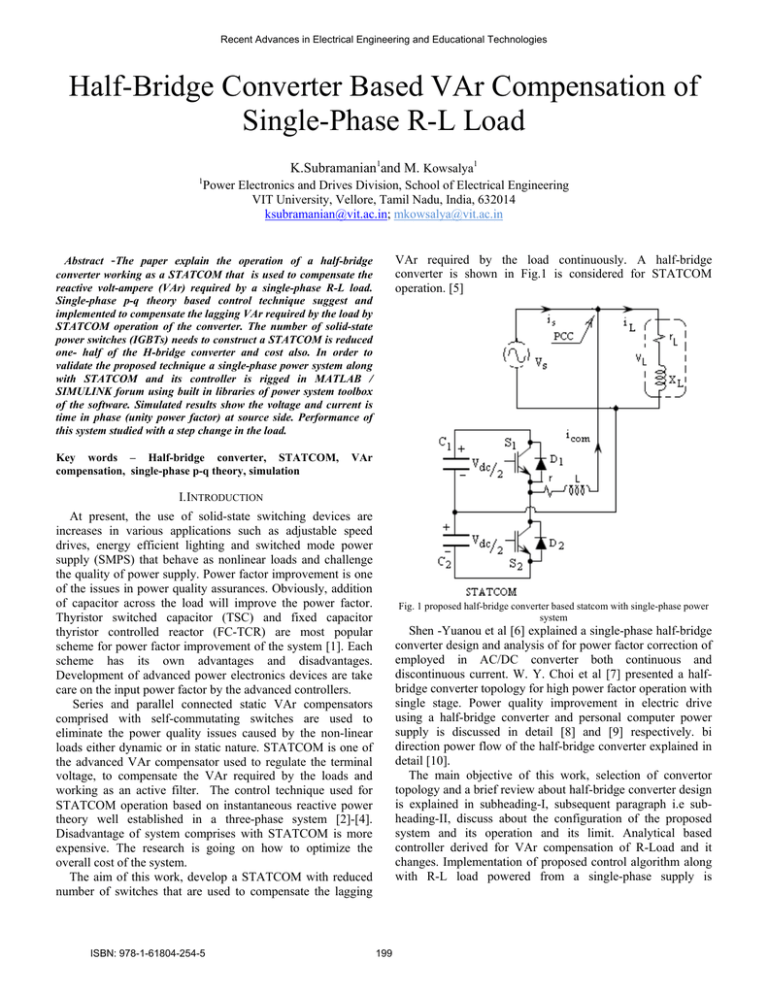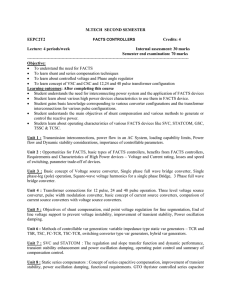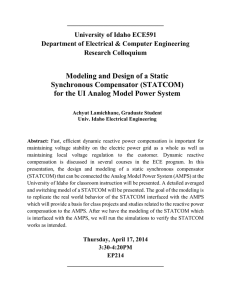Half-Bridge Converter Based VAr Compensation of Single
advertisement

Recent Advances in Electrical Engineering and Educational Technologies Half-Bridge Converter Based VAr Compensation of Single-Phase R-L Load K.Subramanian1and M. Kowsalya1 1 Power Electronics and Drives Division, School of Electrical Engineering VIT University, Vellore, Tamil Nadu, India, 632014 ksubramanian@vit.ac.in; mkowsalya@vit.ac.in VAr required by the load continuously. A half-bridge converter is shown in Fig.1 is considered for STATCOM operation. [5] Abstract -The paper explain the operation of a half-bridge converter working as a STATCOM that is used to compensate the reactive volt-ampere (VAr) required by a single-phase R-L load. Single-phase p-q theory based control technique suggest and implemented to compensate the lagging VAr required by the load by STATCOM operation of the converter. The number of solid-state power switches (IGBTs) needs to construct a STATCOM is reduced one- half of the H-bridge converter and cost also. In order to validate the proposed technique a single-phase power system along with STATCOM and its controller is rigged in MATLAB / SIMULINK forum using built in libraries of power system toolbox of the software. Simulated results show the voltage and current is time in phase (unity power factor) at source side. Performance of this system studied with a step change in the load. Key words – Half-bridge converter, STATCOM, compensation, single-phase p-q theory, simulation VAr I. INTRODUCTION At present, the use of solid-state switching devices are increases in various applications such as adjustable speed drives, energy efficient lighting and switched mode power supply (SMPS) that behave as nonlinear loads and challenge the quality of power supply. Power factor improvement is one of the issues in power quality assurances. Obviously, addition of capacitor across the load will improve the power factor. Thyristor switched capacitor (TSC) and fixed capacitor thyristor controlled reactor (FC-TCR) are most popular scheme for power factor improvement of the system [1]. Each scheme has its own advantages and disadvantages. Development of advanced power electronics devices are take care on the input power factor by the advanced controllers. Series and parallel connected static VAr compensators comprised with self-commutating switches are used to eliminate the power quality issues caused by the non-linear loads either dynamic or in static nature. STATCOM is one of the advanced VAr compensator used to regulate the terminal voltage, to compensate the VAr required by the loads and working as an active filter. The control technique used for STATCOM operation based on instantaneous reactive power theory well established in a three-phase system [2]-[4]. Disadvantage of system comprises with STATCOM is more expensive. The research is going on how to optimize the overall cost of the system. The aim of this work, develop a STATCOM with reduced number of switches that are used to compensate the lagging ISBN: 978-1-61804-254-5 Fig. 1 proposed half-bridge converter based statcom with single-phase power system Shen -Yuanou et al [6] explained a single-phase half-bridge converter design and analysis of for power factor correction of employed in AC/DC converter both continuous and discontinuous current. W. Y. Choi et al [7] presented a halfbridge converter topology for high power factor operation with single stage. Power quality improvement in electric drive using a half-bridge converter and personal computer power supply is discussed in detail [8] and [9] respectively. bi direction power flow of the half-bridge converter explained in detail [10]. The main objective of this work, selection of convertor topology and a brief review about half-bridge converter design is explained in subheading-I, subsequent paragraph i.e subheading-II, discuss about the configuration of the proposed system and its operation and its limit. Analytical based controller derived for VAr compensation of R-Load and it changes. Implementation of proposed control algorithm along with R-L load powered from a single-phase supply is 199 Recent Advances in Electrical Engineering and Educational Technologies described in section -IV. Simulated results are presented in section – V, Conclusion given in section -VI. controllers are developed in different applications [14] – [15]. The subsequent headings explain the individual block in detailed. II. SYSTEM CONFIGURATION Figure 1 shows the proposed system comprises with singlephase power system with R-L load. Two solid-state IGBTs with d.c capacitor working as a STATCOM connected in parallel with load at point of common coupling (PCC) through the inductance , where is the internal resistance of the coil. As STATCOM has inherent characteristics for real power exchange with a support of proper energy storage system, operation of such controller is possible in all quadrants of Q P plane [11]. The power flow relation in a single-phase system is: A. D. C. Voltage Control To maintain the dc bus capacitor voltage of the STATCOM at a reference value, it is sensed and compared with reference at value and then obtained voltage error of the STATCOM sampling instant is given by Where, and are the reference and measured dc voltage of the STATCOM. In this present investigation, the dc voltage reference is set to 204V. The output of the PI controller for maintaining a constant sampling instant is dc bus voltage of the STATCOM at given by Where SA is the apparent power flow, P is the active power flow, Q is the reactive power flow, Vpcc is the system phase voltage(rms) at PCC, Vinv is the STATCOM fundamental output voltage (rms), X (=2πfL) is the leakage reactance, f is the system frequency and α (alpha) the phase angle between Vpcc and Vinv. Variation in α control the active power where as magnitude of voltage for reactive power. For lagging α, power (P) flows from Vinv to Vpcc, for leading α, power (P) flows from Vpcc to Vinv and for α = 0, then P is zero and Q is derived from (1) as: Where is the active power component of the current, which is supplied to meet the losses in the STATCOM by the and are the proportional and integral gain source. constant of the dc bus voltage PI controller respectively. The source should supply the power loss component of the . current B. Estimation of Lagging / Harmonic Current Considered a single-phase system having voltage and the current drawn by the system as: The magnitude of the ac output voltage (Vinv) of STATCOM is controlled by dc capacitor voltage (Vdc) and it is controlled by varying the phase difference between Vc and Vs and also modulation index of the PWM control. III. CONTROL ALOGORITHM In - coordinates, consider phase Figure 2 shows the block diagram of the proposed singlephase synchronous d-q frame theory based control lock for a single-phase STATCOM. and as voltage and current of a The instantaneous active and reactive power can then be obtained as [1]: Where, Fig. 2 over all control block diagram are the dc components in and , corresponds to the production of fundamental voltage and current is given by The generalised instantaneous p-q theory [12] is well established. However instantaneous theory on single-phase circuit presented in details [13]. Based on this theory, different ISBN: 978-1-61804-254-5 and 200 Recent Advances in Electrical Engineering and Educational Technologies and supplying power to a complex load i.e is shown in Fig.4 configured in MATLAB / SIMULINK software. Simulation completed for 0.5 seconds and ode23t is considered to solve the equation govern by the system as shown in Fig.4, In order to investigate the performance of the controller at a step changes in load an additional load power of is connected into the system at 0.2 seconds of simulation time using the switch is shown in Fig.4. Two number of 500μf capacitors are used to maintain the d.c bus voltage of 204 V. A proportional integral controller employed to stabilize the dc voltage level. Therefore, the output voltage of the half-bridge voltage source converter (HBVSC) is controlled which in turn control the current drawn by the converter as a leading or lagging current. An inductor of 30mH is connected in series with the half-bridge voltage source converter. A transformer replaces the inductor in a large-scale system. are oscillating components in and , given by Taking reverse transform of the equation (8) on gives the fundamental component of the currents given by and and is The required lagging current of the load obtained from the measured voltage at PCC and load current. A single-phase P-Q theory based controller will give the control voltage (Vc). It is compared with ramp signal of 2000Hz will generates the gating pulses for the IGBTs. Driver circuit and isolation is necessary in practical system. Here, is the exactly the fundamental component of in real system current .Therefore, the harmonic current obtained as: C. PWM Pulse Generation The single-phase reference source current is comparing with the measured current and the error is feeding to a current controlled PWM pulse generator for switching the IGBT switches. IV. MATLAB/SIMULINK BASED SIMULATION By using the equations (5)–(12), the control blocks are developed in MATLAB / SIMULINK built in library power system toolbox is shown in Fig. 3, to control the reactive volt-ampere required by the load. Fig. 3 proposed controller of MATALB / SIMULINK diagram Fig. 4 proposed controller of MATALB / SIMULINK diagram In conjunction with the developed control circuit and half-bridge converter are connected at PCC of a single-phase power system is shown in Fig.4. A 230V single-phase source (with source inductance) ISBN: 978-1-61804-254-5 201 Recent Advances in Electrical Engineering and Educational Technologies V. SIMULATED RESULTS source alone. By employing STATCOM, the necessary reactive current drawn by the load is supplied by the STATCOM by controlling the dc voltage level. Therefore the source current is time in phase with voltage is shown in Fig.5(c),where as load voltage and load current is shown in Fig.5(e). The simulated results of the study system are stored in the scope is shown in Fig.5. Those voltage magnitudes are reduces with gain of 1/30 for comparing with current waveform. Without STATCOM the voltage and current waveforms of source and load is shown in Figs 5(a) & Fig. 5(b) respectively. It shows both active and reactive power is supplied by the Fig. 5 Simulated results (a) Extracted source voltage and current waveforms without STATCOM (b) Extracted load voltage and current waveforms without STATCOM (c) Extracted source voltage and current waveforms with STATCOM (d) Extracted load voltage and current waveforms with STATCOM (e) Extracted source voltage and current waveforms with STATCOM and additional load ISBN: 978-1-61804-254-5 202 Recent Advances in Electrical Engineering and Educational Technologies it generates harmonics it can be extended to large scale system simple in control it can be working as VAr compensator it reduces the power switch it has low switch loss overall system efficiency improved Properly designed passive filter could able to eliminate the higher order harmonics generated by the half-bridge STATCOM. Capability of the STATCOM working as a voltage regulator and active filter is for further investigation. It is a lagging power factor and needs reactive current, which is compensated by the STATCOM current as shown in Fig. (6). its magnitude changed as when as load current change. ACKNOWLEDGMENT The authors acknowledge the Management of Vellore Institute of Technology University, Vellore, India, 632014 and Dean School of Electrical Engineering, for the support and keen interest in promoting the research and development in the division by providing the facilities and time. REFERENCES [1] [2] [3] Fig. 6 simulated converter output voltage and current Figure 6 illustrates the simulated voltage capture at PCC and current flowing through the inductor (L) waveforms. it show current is in peak magnitude while voltage goes to zero at 0.47 and 0,49 seconds concludes that capacitive in nature. The source current has harmonic components is shown in Fig.7. [4] [5] [6] [7] [8] [9] [10] Fig. 7 simulated converter output voltage and current [11] Attempt made in investigate the source current harmonics, Fig.7. It shows third harmonic is predominant over others. It is well known that 3rd harmonics are could be eliminated by three-phase delta connected system and higher harmonics are easily filtered by the passive filter networks. VI. [12] [13] CONCLUSION Half-bridge VSC controller derived using single-phase P-Q theory and implemented. The observation of the simulation work is ISBN: 978-1-61804-254-5 [14] 203 T.J.E Miller, ‘Reactive Power Control in Electrical System’, John Wiley Publication Narain Hingorani and Laszho Gyugi, Understanding FACTS, 2000. Mohan Mathur, R. and Rajiv K.Verma, Thyristor based FACTS controllers for electrical transmission system, IEEE Press, A John Wiley & Sons Inc. publication, 2002 Padiyar, K. R., FACTS controllers in power transmission and distribution, 2007 Guidong Zhang, Zhong Li and Bo Zhang, “ A Z-Source HalfBridge Converter”, IEEE Transaction on Induastrial Electronics, Vol.61, No.3, March 2014, pp 1269 - 1279. W.Y.Choi, J.M. Kwon, H. L. Do and B. H. Kwon, “Single stage half bridge Converter with high power factor”, IET Proc. Power Application, Vol.152. No.3, May 2005,,pp. 634 -642. Sheng-Yuan Ou, Ho-Pu Hsiao and Chen-Hung Tien, “Analysis and Design of a Prototupe Single stage JHalf-bridge Conevrter”, 5th IEEE conferecne on Industrial Electronics and Application s IEEE Conference Proceeding, 2010, pp 1168 - 1173. Bhim Singh and Sanjeev Singh, “Half Brige Boost Conevrter For Power Quality Improvement In PMBLDCM Drive” Second International Conference on Emering Trends in Engineering and Technologies, ICETET-09, IEEE Conference Proceeding, 2009, pp. 753 -758. Kyu-Min Cho, Won-Sik Oh, Kcun-Wook Lee and Gun-Woo Moon, “A New Half-Bridge Converter For The Personal Computer Power Supply”, IEEE Conference Proceeding, 2008, pp. 986 991. Tuan ngo, Jehyuk Won and Kwanghee Nam,“Single-Phase Bidirectional Dual Active Half-Bridge Converter”, IEEE Conference Proceeding, 2012, pp. 1127 -1133. Bhim Singh, S. S. Murthy and Sushma Gupta, “A Stand-Alone Generating System Using Self-Excited Induction Generators in the Extraction of Petroleum Products, IEEE Transaction on Industry applications, Vol.46, No.1, 2010, pp. 94 - 101. H. Akagi, Y. Kanazawa and A.Nabae, “ Generalised theory of the instantaneous reactive power in three-phase cirucits”, IEEE conference proceeding, 1983, pp 1375 - 1386. M. Tarafdar Haque,“Single-phase PQ theory for active filter”, TENCON 02, IEEE conference proceeding, 2002, pp 1941 – 1944. Suganjian PENG, AN LUO, Zhipeng LV, Jingbing WU and Li Yu, “Power control for Single-phase Microgrid based on PQ theory”, 6th IEEE conferecne on Industrial Electronics and Application s IEEE conference proceeding, 2011, pp 1274 - 1944 Recent Advances in Electrical Engineering and Educational Technologies [15] Subhash Joshi T.G, Aby Joseph and Unnikrishnan A. K., “ Harmonic Extraction Of Non-Linear Load Operating In Wide Frequency Variations”, IEEE conference proceeding, 2012, pp 463 - 468. ISBN: 978-1-61804-254-5 204


